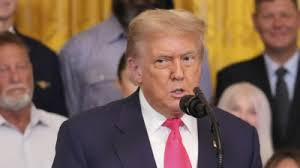‘Very big one’: Donald Trump hints at trade deal with India after China pact

Just days after finalizing a significant trade agreement with China, former U.S. President Donald Trump has turned his attention to India, hinting at what he called a “very big one” in terms of trade relations. With global markets closely watching the shifting sands of international diplomacy, Trump’s comments have stirred curiosity—and cautious optimism—among economic observers, Indian policymakers, and American business leaders alike.
But what does this mean for India–U.S. trade relations? Could this be the beginning of a major economic pivot? And what stands in the way of making this deal a reality?
The Context: U.S.–China Deal Sets the Stage
The Trump administration’s success in locking in a fresh deal with China has had ripple effects across the geopolitical landscape. That agreement focused heavily on reducing tariffs and strengthening supply chain cooperation, especially in rare earth minerals, semiconductors, and consumer goods. With that chapter closed, attention has swiftly shifted to India—an emerging global powerhouse with whom the U.S. shares not just economic but strategic interests.
While speaking at a recent event, Trump remarked, “We’re going to open up India. Not every country gets that.” This comment, although vague, strongly suggested that the next major trade focus will be on deepening ties with New Delhi.
Why India?
India has long been seen as a vital U.S. partner in the Indo-Pacific region. As the world’s most populous country and a rapidly growing economy, India offers vast potential for trade, technology cooperation, and investment.
In 2024, bilateral trade between India and the U.S. stood at over $190 billion, with both sides targeting a goal of $500 billion by 2030. For Washington, India is not just a counterweight to China but a promising market for American goods—especially in defense, energy, pharmaceuticals, agriculture, and digital services.
From India’s side, a comprehensive trade deal could mean:
- Reduced tariffs on key exports like textiles, leather, and IT services
- Greater access to U.S. markets for agricultural goods
- Enhanced collaboration on digital trade, AI, and green energy
- Potential technology transfer in defense and aerospace sectors
Key Issues in the Negotiation
While Trump’s comment about a “very big” deal may sound promising, the path to a finalized agreement is fraught with complications.
1. Agriculture and Auto Sectors
The U.S. has long pushed for greater access to India’s agricultural and automobile markets. Washington wants India to lower tariffs on American grains, dairy products, and automobiles—an ask that faces resistance from Indian farmers and local industries that fear being undercut.
2. Tariff Deadlines and Pressures
A looming tariff deadline of July 9, 2025, is acting as both a motivator and a pressure point. Without a deal, reciprocal tariffs of up to 26% on key Indian exports could come into effect—hurting small and medium enterprises in both countries.
3. Digital Trade and Data Localization
The U.S. is also concerned about India’s data localization laws, which require companies to store data on Indian soil. American tech giants see this as a hindrance, while India views it as a necessary move for data sovereignty and national security.
4. Health and Safety Standards
Non-tariff barriers remain another stumbling block. Indian exports such as spices and generic medicines often face U.S. scrutiny over quality and compliance with FDA regulations. Any new deal would need to create harmonized standards or mutual recognition frameworks.
India’s Position: Fair and Balanced Deal
Commerce Minister Piyush Goyal has maintained that India is open to a comprehensive trade agreement—but only if it’s “fair, balanced, and mutually beneficial.” India does not want to be perceived as a junior partner and seeks a deal that respects its developmental priorities and domestic industries.
At a recent press briefing, Goyal said, “We are in advanced stages of talks. A deal is possible, but we must ensure it benefits our people and protects our farmers, workers, and small businesses.”
Strategic Implications Beyond Trade
This potential trade deal is not just about dollars and cents. It has deep strategic implications.
- Geopolitical Realignment: As U.S.–China tensions continue, Washington sees India as a vital democratic ally in Asia.
- Global Supply Chains: A trade deal could help both countries diversify supply chains, especially in electronics, pharmaceuticals, and semiconductors.
- Defense and Security: Enhanced trade ties are often accompanied by greater cooperation in defense, cybersecurity, and counterterrorism.
In short, this deal could cement India’s role as a central figure in a new world order.
Outlook: Will the “Very Big One” Materialize?
With the July 9 deadline fast approaching, time is short—but not impossible. Both sides are motivated, and with some give and take, a deal could be struck.
However, much depends on the domestic political climate in both nations. Trump’s electoral ambitions and India’s ongoing economic reforms may impact the timeline and content of any agreement.
For now, the world watches as two major democracies try to bridge gaps and forge what could be one of the most significant trade deals of the decade.
Conclusion: A Defining Moment for U.S.–India Relations
Trump’s statement has added momentum to already advancing trade talks. If successful, this agreement could be a game-changer—not just for the economies of the U.S. and India but for global trade at large. Whether it becomes a reality depends on delicate diplomacy, swift negotiations, and mutual trust. But one thing is clear: the appetite for a “very big” deal is real, and the stakes are high.






